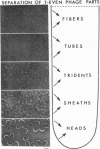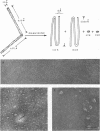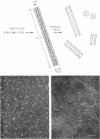Abstract
T-even bacteriophages were grown and purified in bulk quantities. The protein coats were disrupted into their component substructures by treatment with 67% dimethyl sulfoxide (DMSO). Tail fibers and tubes were purified on glycerol-CsCl-D2O gradients and examined with respect to sedimentation properties, subunit molecular weights, amino acid composition, isoelectric points, and morphology. It was found that intact tail fibers had a sedimentation coefficient of 12 to 13S and that dissociated fibers consisted of three classes of proteins having molecular weights of 150 K ± 10, 42 K ± 4, and 28 K ± 3 daltons. A model was constructed in which the 150-K subunit folded back on itself twice to give a three-stranded rope. Each 150-K subunit then represented a half-fiber and it was proposed that the role of the 42- and 28-K subunits was to hold each half-fiber together as well as serve as a possible link with other substructures. Isoelectric point studies also indicated that there were three different proteins with pI values of 3.5, 5.7, and 8.0. Amino acid analyses indicated that fibers had a composition distinct from other phage substructures. In addition, a striking difference was noted in the content of tryptophan among the phages examined. T4B had three to five times more tryptophan than did T2L, T2H, T4D, and T6. Intact tail tubes had an S20,w of 31 to 38S and dissociated tubes consisted of three proteins of molecular weights 57 K ± 5, 38 K ± 4, and 25 K ± 3 daltons. Based on degradation studies with DMSO, it was proposed that these three proteins were arranged in a helical array yielding the tube structure. Isoelectric point studies indicated that there were three major proteins in the tube whose pI values were 5.1, 5.7, and 8.5. No significant differences were observed in the amino acid content of tubes obtained from all the T-even bacteriophages.
Full text
PDF










Images in this article
Selected References
These references are in PubMed. This may not be the complete list of references from this article.
- BRENNER S., HORNE R. W. A negative staining method for high resolution electron microscopy of viruses. Biochim Biophys Acta. 1959 Jul;34:103–110. doi: 10.1016/0006-3002(59)90237-9. [DOI] [PubMed] [Google Scholar]
- CUMMINGS D. J. SEDIMENTATION AND BIOLOGICAL PROPERTIES OF T-PHAGES OF ESCHERICHIA COLI. Virology. 1964 Jul;23:408–418. doi: 10.1016/0042-6822(64)90264-8. [DOI] [PubMed] [Google Scholar]
- CUMMINGS D. J. Subunit basis of head configurational changes in T2 bacteriophage. Biochim Biophys Acta. 1963 Mar 26;68:472–480. doi: 10.1016/0006-3002(63)90169-0. [DOI] [PubMed] [Google Scholar]
- Cummings D. J., Chapman V. A., DeLong S. S. Disruption of T-even bacteriophages by dimethyl sulfoxide. J Virol. 1968 Jun;2(6):610–620. doi: 10.1128/jvi.2.6.610-620.1968. [DOI] [PMC free article] [PubMed] [Google Scholar]
- Cummings D. J., Chapman V. A., DeLong S. S., Kusy A. R., Stone K. R. Characterization of T-even bacteriophage substructures. II. Tail plates. J Virol. 1970 Oct;6(4):545–555. doi: 10.1128/jvi.6.4.545-555.1970. [DOI] [PMC free article] [PubMed] [Google Scholar]
- Cummings D. J., Chapman V. A., DeLong S. S. The sedimentation and conformational variance among T-even bacteriophages. Virology. 1969 Jan;37(1):94–108. doi: 10.1016/0042-6822(69)90310-9. [DOI] [PubMed] [Google Scholar]
- Cummings D. J., Mondale L. Density-gradient banding of denatured deoxyribonucleic acid in cesium sulphate. Biochim Biophys Acta. 1966 Jul 13;120(3):448–453. doi: 10.1016/0926-6585(66)90311-6. [DOI] [PubMed] [Google Scholar]
- Dale G., Latner A. L. Isoelectric focusing in polyacrylamide gels. Lancet. 1968 Apr 20;1(7547):847–848. doi: 10.1016/s0140-6736(68)90303-6. [DOI] [PubMed] [Google Scholar]
- Davison P. F. Proteins in denaturing solvents: gel exclusion studies. Science. 1968 Aug 30;161(3844):906–907. doi: 10.1126/science.161.3844.906. [DOI] [PubMed] [Google Scholar]
- Edgar R. S., Lielausis I. Serological studies with mutants of phage T4D defective in genes determining tail fiber structure. Genetics. 1965 Dec;52(6):1187–1200. doi: 10.1093/genetics/52.6.1187. [DOI] [PMC free article] [PubMed] [Google Scholar]
- Edgar R. S., Lielausis I. Some steps in the assembly of bacteriophage T4. J Mol Biol. 1968 Mar 14;32(2):263–276. doi: 10.1016/0022-2836(68)90008-9. [DOI] [PubMed] [Google Scholar]
- Forrest G. L., Cummings D. J. Head proteins from T-even bacteriophage. I. Molecular weight characterization. J Virol. 1970 Mar;5(3):398–405. doi: 10.1128/jvi.5.3.398-405.1970. [DOI] [PMC free article] [PubMed] [Google Scholar]
- HERRIOTT R. M., BARLOW J. L. The protein coats or ghosts of coliphage T2. I. Preparation, assay, and some chemical properties. J Gen Physiol. 1957 May 20;40(5):809–825. doi: 10.1085/jgp.40.5.809. [DOI] [PMC free article] [PubMed] [Google Scholar]
- HIRS C. H., STEIN W. H., MOORE S. The amino acid composition of ribonuclease. J Biol Chem. 1954 Dec;211(2):941–950. [PubMed] [Google Scholar]
- HIRS C. H. The oxidation of ribonuclease with performic acid. J Biol Chem. 1956 Apr;219(2):611–621. [PubMed] [Google Scholar]
- KELLENBERGER E., BOLLE A., BOYDELATOUR E., EPSTEIN R. H., FRANKLIN N. C., JERNE N. K., REALE SCAFATI A., SECHAUD J. FUNCTIONS AND PROPERTIES RELATED TO THE TAIL FIBERS OF BACTERIOPHAGE T4. Virology. 1965 Jul;26:419–440. doi: 10.1016/0042-6822(65)90006-1. [DOI] [PubMed] [Google Scholar]
- King J. Assembly of the tail of bacteriophage T4. J Mol Biol. 1968 Mar 14;32(2):231–262. doi: 10.1016/0022-2836(68)90007-7. [DOI] [PubMed] [Google Scholar]
- King J., Wood W. B. Assembly of bacteriophage T4 tail fibers: the sequence of gene product interaction. J Mol Biol. 1969 Feb 14;39(3):583–601. doi: 10.1016/0022-2836(69)90147-8. [DOI] [PubMed] [Google Scholar]
- McConahey P. J., Dixon F. J. A method of trace iodination of proteins for immunologic studies. Int Arch Allergy Appl Immunol. 1966;29(2):185–189. doi: 10.1159/000229699. [DOI] [PubMed] [Google Scholar]
- Poglazov B. F., Nikolskaya T. I. Self-assembly of the protein of bacteriophage T2 tail cores. J Mol Biol. 1969 Jul 14;43(1):231–233. doi: 10.1016/0022-2836(69)90094-1. [DOI] [PubMed] [Google Scholar]
- SARKAR N., SARKAR S., KOZLOFF L. M. TAIL COMPONENTS OF T2 BACTERIOPHAGE. I. PROPERTIES OF THE ISOLATED CONTRACTILE TAIL SHEATH. Biochemistry. 1964 Apr;3:511–517. doi: 10.1021/bi00892a008. [DOI] [PubMed] [Google Scholar]
- SARKAR S., SARKAR N., KOZLOFF L. M. TAIL COMPONENTS OF T2 BACTERIOPHAGE. II. PROPERTIES OF THE ISOLATED TAIL CORES. Biochemistry. 1964 Apr;3:517–521. doi: 10.1021/bi00892a009. [DOI] [PubMed] [Google Scholar]
- STUDIER F. W. SEDIMENTATION STUDIES OF THE SIZE AND SHAPE OF DNA. J Mol Biol. 1965 Feb;11:373–390. doi: 10.1016/s0022-2836(65)80064-x. [DOI] [PubMed] [Google Scholar]
- To C. M., Kellenberger E., Eisenstark A. Disassembly of T-even bacteriophage into structural parts and subunits. J Mol Biol. 1969 Dec 28;46(3):493–511. doi: 10.1016/0022-2836(69)90192-2. [DOI] [PubMed] [Google Scholar]





